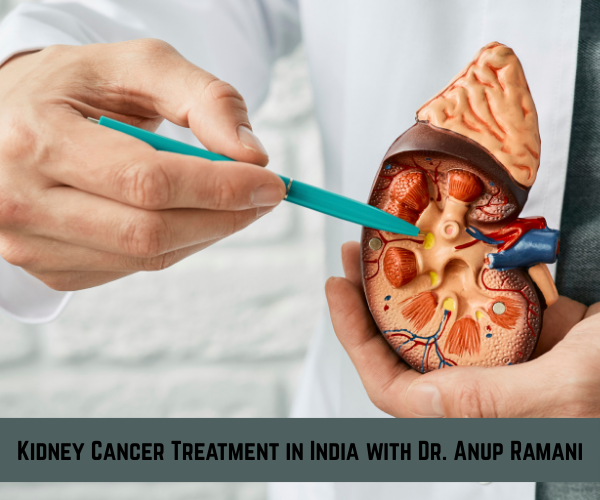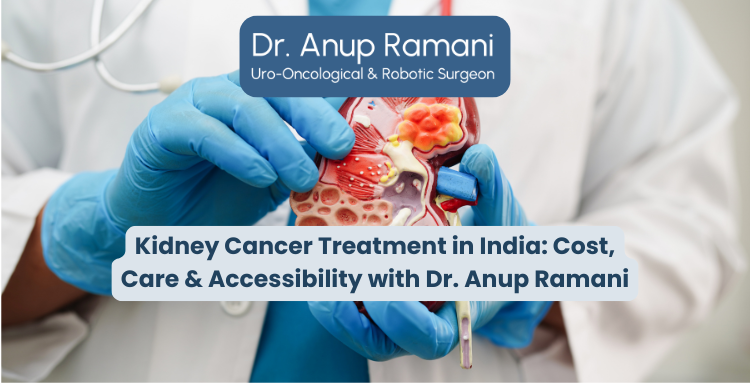Dr Anup Ramani @ Copyright 2024
By Dr. Anup Ramani
Kidney cancer, also known as renal cancer, occurs when cancer cells develop in the kidneys. In India, kidney cancer treatment is accessible and relatively affordable compared to many developed countries, making it an attractive destination for medical tourism. The treatment for kidney cancer typically includes surgery, immunotherapy, targeted therapy, radiation therapy, and sometimes, ablation techniques. The choice of treatment depends on the stage of cancer, type, and the patient’s overall health.
In this article, we’ll explore kidney cancer treatment options in India, the factors influencing costs, and why consulting Dr. Anup Ramani, a renowned specialist in minimal invasive surgery, robotic radical nephrectomy, and partial nephrectomy, could be a great choice for patients seeking effective and affordable treatment.
What Are the Different Treatment Options for Kidney Cancer in India?
In India, kidney cancer treatment is approached in a multi-faceted manner, involving various modalities depending on the stage and type of cancer.
Surgery:
Surgery is the most common treatment for kidney cancer, particularly in the early stages. Two main types of surgery are performed:
- Radical Nephrectomy: This is the removal of the entire kidney, surrounding tissue, and possibly affected lymph nodes. It is usually recommended if the tumor is large or located in a way that makes partial removal difficult.
- Partial Nephrectomy: In this procedure, only the tumor and a margin of healthy tissue around it are removed. This surgery preserves the rest of the kidney, which is ideal for patients with localized tumors who wish to maintain kidney function.
Both surgeries can be performed using open surgery, laparoscopic surgery, or robotic-assisted surgery. The choice of surgery depends on the tumor’s size, location, and the patient’s health.
Minimal Invasive Surgery:
- Laparoscopic Surgery: Involves small incisions and the use of a camera, allowing for a quicker recovery and fewer complications compared to traditional open surgery.
- Robotic Radical/Partial Nephrectomy: A more advanced, Minimal invasive approach that utilizes robotic assistance to enhance precision, allowing for smaller incisions, less blood loss, and faster recovery.
These advanced surgical approaches, especially robotic surgery, can be particularly beneficial for patients, as they significantly reduce the risk of complications and shorten the recovery time.
Targeted Therapy:
Immunotherapy:
Immunotherapy boosts the immune system to help fight kidney cancer cells. It is often recommended for Stage III and Stage IV kidney cancer. It has shown promising results in improving survival rates and preventing cancer recurrence.

Radiation Therapy:
High-energy radiation is used to shrink tumors or kill cancer cells. Radiation is generally used when surgery is not possible, or as palliative care for pain relief in advanced cases.
Ablation Techniques:
- Radiofrequency Ablation (RFA): Uses heat from an electric current to destroy cancer cells. RFA is often recommended for small kidney tumors and is performed through a needle inserted into the tumor.
- Cryoablation: Uses extreme cold to freeze and destroy cancer cells. Like RFA, this procedure is suitable for small tumors and is Minimal invasive.
What Are the Factors That Influence Kidney Cancer Treatment Costs in India?
The cost of kidney cancer treatment in India varies depending on several factors, which include:
- Stage of Cancer: Early-stage cancers (Stage I and II) typically require surgery, which may cost less. Advanced stages (Stage III and IV) may require additional therapies like immunotherapy, targeted therapy, or radiation, making treatment more expensive.
- Type of Treatment: Surgical approaches, such as robotic surgery and laparoscopic surgery, tend to be more expensive than traditional open surgery due to advanced technology. Therapies like immunotherapy and targeted therapy also increase the cost.
- Doctor’s Expertise: The experience of the doctor and their specialization in kidney cancer treatment also influence costs. Dr. Anup Ramani, renowned for performing Minimal invasive kidney surgeries such as robotic radical nephrectomy and partial nephrectomy, ensures that patients receive the best treatment with Minimal invasive techniques, reducing recovery time and complications.
- Hospital Location: Treatment costs can also vary by city and hospital.
- Post-Operative Care: The cost of post-operative care, including medications, rehabilitation, and follow-up visits, can add to the total treatment expenses.
What is the Average Cost of Kidney Cancer Treatment in India?
While the cost of kidney cancer treatment varies widely, it is generally much more affordable in India compared to Western countries. The average costs for kidney cancer treatment in India are significantly lower, often 60-70% less than in countries like the United States or the United Kingdom.
For accurate cost estimates based on your specific case, it’s advisable to consult Dr. Anup Ramani in Mumbai, who specializes in offering affordable treatments through advanced techniques like minimal invasive surgery and robotic surgery.
Why Should You Consult Dr. Anup Ramani for Kidney Cancer Treatment?
Dr. Anup Ramani, based in Mumbai, is a highly experienced urologist and kidney cancer surgeon known for his expertise in robotic surgery, Minimal invasive surgery, and partial nephrectomy. His approach minimizes post-surgical recovery time and reduces the risk of complications, making him a preferred choice for kidney cancer treatment.
Dr. Ramani offers personalized treatment plans for each patient, taking into account the stage of cancer, overall health, and treatment goals. Whether you need radical nephrectomy, partial nephrectomy, or Minimal invasive robotic surgery, Dr. Ramani provides the best possible care using the latest technologies.
What Our Patients Are Saying
What is the Success Rate of Kidney Cancer Treatment in India?
India boasts a high success rate in kidney cancer treatments, with many studies reporting an 85-90% survival rate for patients who undergo surgery and follow appropriate treatment protocols. The five-year survival rate for early-stage kidney cancer can range from 81-93%, depending on the cancer stage and the effectiveness of the treatment.
With Dr. Anup Ramani’s expertise and modern, Minimal invasive surgical techniques, the chances of successful outcomes are significantly improved.
How Accessible Is Kidney Cancer Treatment in India?
India has become a hub for medical tourism due to its high-quality healthcare at affordable prices. Kidney cancer treatment is widely accessible, with advanced treatment centers in major cities like Mumbai, Delhi, Chennai, and Bangalore. Patients from both within India and abroad flock to India for its world-class medical services.
India’s medical infrastructure is state-of-the-art, with leading hospitals equipped to provide comprehensive care for kidney cancer patients, including advanced diagnostic facilities, surgery, chemotherapy, and post-operative care.
What Factors Should Be Considered When Choosing a Hospital for Kidney Cancer Treatment?
When choosing a hospital for kidney cancer treatment, consider the following factors:
- Expertise of the doctor: Ensure the doctor has experience in treating kidney cancer and performing Minimal invasive surgeries like robotic radical nephrectomy.
- Technology and equipment: Choose hospitals that offer advanced treatments like robotic surgery, targeted therapies, and radiation therapy.
- Cost: Consider the overall cost of treatment, including surgery, therapy, and post-surgical care.
- Patient reviews and success rates: Look for hospitals with a high success rate and positive patient testimonials.
Conclusion
Kidney cancer treatment in India offers a wide range of options, from surgery to immunotherapy and radiation therapy. The country provides world-class treatment at a fraction of the cost compared to developed nations. Dr. Anup Ramani in Mumbai offers cutting-edge, affordable treatments through advanced techniques like minimal invasive surgery, robotic radical nephrectomy, and partial nephrectomy, ensuring the best outcomes for patients.
While treatment costs vary depending on the stage of cancer, type of treatment, and the hospital chosen, India remains an excellent option for kidney cancer care, with high success rates and modern medical infrastructure. If you or a loved one is seeking treatment for kidney cancer, consulting Dr. Anup Ramani for personalized care could be the key to ensuring the best treatment possible.
About Author

Uro-Oncological & Robotic Surgeon
Dr. Anup Ramani is a robotic uro-oncological surgeon and an internationally recognized expert in robotic surgery for prostate, kidney and urinary bladder cancers. With more than two decades of robotic experience and 2,000+ robotic procedures, he brings unmatched precision and outcomes to complex uro-oncology cases. He is widely published in his field and is known for a personal, transparent approach-often spending over an hour in initial consultations to educate patients on its disease, surgery and recovery. His expertise spans prostate cancer treatment, kidney and bladder cancer surgery, adrenal gland surgery, kidney stone treatment, penile cancer surgery and enlarged prostate management. Dr. Ramani advocates the advantages of robotic surgery-magnified 3D vision, tremor-filtered precision, minimal scarring, lower blood loss and faster recovery-helping patients return to life sooner.
Table of Contents
Recent Blogs
Best Uro-Oncological surgeon
Specialist in India for Robotic Surgery
MCh, DNB, MS, DNB
Dr. Anup Ramani
CONTACT
Uro-Oncologist in India,
Best Robotic Surgeon for Uro Oncology Surgery
1407, One Lodha Place Next to World Towers Senapati Bapat Marg, Worli, Mumbai. 400013.
Dr Anup Ramani @ Copyright 2024 – Website Maintenance, SEO & GEO by Opal Infotech
- Partial penectomy is done in cases where glans and distal penis is involved with carcinoma.
- Partial penectomy is a type of organ-preserving surgery. Preservation of sexual and micturational function depends on the surgical dissection and reconstruction of residual urethra.
- Patients who develop stones in the kidney or ureter, often experience severe pain.
- This condition usually needs a procedure to remove the kidney stones.
- This procedure is called ureteroscopy and is performed very commonly.
- It does not require any cuts and hence it is painless.
- The procedure is performed with an endoscope inserted through the penis under spinal anesthesia.
- The scope is inserted through the penis into the kidney and stones are dissolved with a laser.
- The procedure takes about 40-50 minutes.
- A catheter (urine pipe) is kept after the procedure to drain the bladder. A stent is kept in the kidney at the same time.
- Patient is mobile and walking in the room the same evening.
- Hospital stay is one night and patient is discharged the next day after removal of the catheter.
- Patient has to come back after six weeks to remove the stent in the kidney.
- Patients can resume office a week after surgery and heavy activities like running, weight lifting, a month after the procedure.
- We offer fixed packages for this procedure which can be obtained by calling our helpline +91 9967666060.
- Men with an enlarged prostate, which is a normal ageing changes, often experiencing difficulty passing urine. This condition usually needs a procedure to trim the prostate and relieve the blockage.
- This procedure is called TURP and is performed very commonly.
- It does not require any cuts and hence it is painless.
- The procedure is performed with an endoscope inserted through the penis under spinal anaesthesia.
- The overgrown prostate is dissolved with a laser bloodlessly.
- The procedure takes about 40 minutes.
- A catheter (urine pipe) is kept after the procedure to drain the bladder.
- Patient is mobile and walking in the room the same evening.
- Hospital stay is two nights and patient is discharged with the catheter, which is removed after 4 days.
- Patients can resume office a week after surgery and heavy activities like running, weight lifting, a month after the procedure.
- We offer fixed packages for this procedure which can be obtained by calling our helpline +91 9967666060.
-
Robotic adrenalectomy is a sophisticated, complex surgery and it is very important that an experienced surgeon performs this surgery to avoid major complications.
-
Once the anesthesia is done, and patient positioned, three micro cuts (3mm each) are made in the patient’s abdomen.
-
The arms of the Da Vinci robot are connected to the cuts via ports (tubes).
-
Dr. Ramani then sits in the controlling console to perform the surgery.
-
On an average, a robotic adrenalectomy takes one hour.
-
The surgery is almost completely bloodless and there has never been any need to transfuse blood after surgery.
-
A urine catheter and bag to drain the bladder is inserted during surgery.
-
A tiny drain pipe may be inserted in the surgical side of the abdomen, connected to a bag.
-
Patient is kept nil-by-mouth the day of the surgery, with IV fluids. Sips of water are started the next day and solid food by day three.
-
The drain pipe, if kept, is removed in the room on day 2 after surgery.
-
The catheter is removed on day two after surgery.
-
Total hospital stay for robotic adrenalectomy is 4 nights (including night before surgery).
-
Post discharge, a doctor from the surgical team visits the patient at home/ hotel room once every day.
On the day of discharge, patient is totally self-sufficient. They are able to walk freely without any pain, dress themselves, shower, toilet and they do not need to hire any nurse or help at home. Almost all patients are back to work within 2 weeks of surgery.
Heavy activities like running, weight lifting can be resumed after a month
Follow up after an adrenalectomy is in the form of CT scans, once a year for 5 years.
Local patients usually meet Dr. Ramani after two weeks to discuss report.Outstation patients are counselled on a phone consultation.
- Dr. Ramani is one of the very few surgeons in India who has the expertise to perform a robotic surgery for bladder cancer, which includes removing the urinary bladder and reconstructing a new bladder robotically.
- Robotic radical cystectomy is an extremely sophisticated, complex surgery and it is very important that an experienced surgeon performs this surgery to avoid major complications.
- Once the anaesthesia is done, and patient positioned, six micro cuts (3mm each) are made in the patient’s abdomen.
- The arms of the Da Vinci robot are connected to the cuts via ports (tubes).
- Dr. Ramani then sits in the controlling console to perform the surgery.
- On an average, a robotic radical cystectomy with an ileal conduit takes 3-4 hours.
- The surgery is almost completely bloodless and there has never been any need to transfuse blood after surgery.
- A urine catheter and bag to drain the new bladder is inserted during surgery.
- Two tiny drain pipe in inserted in the surgical side of the abdomen, connected to a bag.
- Patient is kept nil-by-mouth for 4 days after surgery with IV supplementation of patient’s daily requirements of calories, fats, carbohydrates, proteins and electrolytes.
- The drain pipes are removed in the room on day 3-5 after surgery.
- Total hospital stay for radical cystectomy is 8 nights (including night before surgery).
- Post discharge, a doctor from the surgical team visits the patient at home/ hotel room once every day.
- On the day of discharge, patient is totally self-sufficient. They are able to walk freely without any pain, dress themselves, shower, toilet and they do not need to hire any nurse or help at home.
- Almost all patients are back to work within 6 weeks of surgery. Heavy activities like running, weight lifting can be resumed after two months.
Follow up after a radical a cystectomy is in the form of CT scans, once a year for 5 years.
Histopathology report: Local patients usually meet Dr. Ramani after two weeks to discuss report.
Outstation patients are counselled on a phone consult. Depending on the report, patient may or may not need chemotherapy after surgery.
If chemo is needed, patients may choose to get it done with a medical oncologist of their choice or avail the services of one of the four medical oncologists on our team.
- Robotic partial nephrectomy is a sophisticated, complex surgery and it is very important that an experienced surgeon performs this surgery to avoid major complications. Robotic radical (total) nephrectomy is
- relatively easier but still requires significant experience to consistently deliver results.
- Once the anaesthesia is done, and patient positioned, five micro cuts (3mm each) are made in the patient’s abdomen.
- The arms of the Da Vinci robot are connected to the cuts via ports (tubes).
- Dr. Ramani then sits in the controlling console to perform the surgery.
- On an average, a robotic radical nephrectomy takes one hour and a robotic partial nephrectomy takes about an hour and half.
- The surgery is almost completely bloodless and there has never been any need to transfuse blood after surgery.
- A urine catheter and bag to drain the bladder is inserted during surgery.
- A tiny drain pipe in inserted in the surgical side of the abdomen, connected to a bag.
- Patient is kept nil-by-mouth the day of the surgery, with IV fluids. Sips of water are started the next day and solid food by day three.
- The drain pipe is removed in the room on day 3 after surgery. The catheter is removed on day two after surgery.
- Total hospital stay for radical/partial nephrectomy is 4 nights (including night before surgery).
- Post discharge, a doctor from the surgical team visits the patient at home/ hotel room once every day.
- On the day of discharge, patient is totally self- sufficient.
- They are able to walk freely without any pain, dress themselves, shower, toilet and they do not need to hire any nurse or help at home.
- Almost all patients are back to work within 2-3 weeks of surgery.
- Heavy activities like running, weight lifting can be resumed after a month.
- Follow up after a radical/partial Nephrectomy is in the form of CT scans, once a year for 5 years.
- Local patients usually meet Dr. Ramani after two weeks to discuss report.
- Outstation patients are counselled on a phone consultation.






